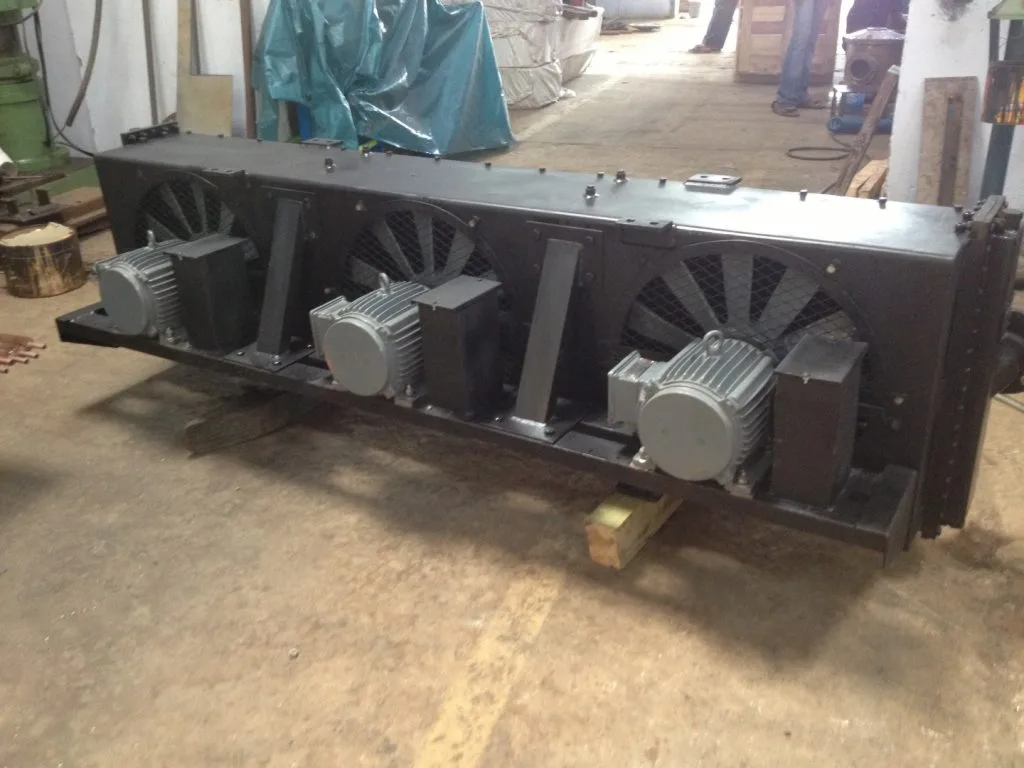An airblast oil cooler uses airflow to lower the temperature of hot oil, commonly found in hydraulic and lubrication systems. Unlike water cooled systems, airblast coolers use a fan to force air across a finned surface where the oil flows. As air passes over these fins, it absorbs heat from the oil and carries it away.
It’s an efficient and self contained cooling solution that eliminates the need for water supply lines, water treatment, or drainage. This makes it ideal for remote locations, mobile machinery, and applications where water is not available or practical.

How Does It Work and Why Is It Essential in Industrial Systems?
In industrial applications whether in mobile machinery, hydraulic systems, construction equipment, or stationary industrial plants managing oil temperature is critical. Overheated oil can degrade rapidly, reduce equipment lifespan, and compromise safety and performance. That’s where the Airblast Oil Cooler comes in.
But what exactly is an airblast oil cooler, how does it function, and why is it increasingly used across a wide range of industries? In this article, we’ll answer all these questions and more helping you understand not only what it is, but also how it works, where it’s used, what benefits it offers, and how to select the right one.
How Does an Airblast Oil Cooler Work?
- Hot Oil Enters the Cooler: The oil, heated through system operation, enters the cooler through an inlet manifold.
- Oil Flows Through Tubes or Plates: Inside the cooler, oil flows through tubes or plate-fin assemblies with aluminum fins to improve heat transfer.
- Air Is Forced Across the Finned Surfaces: A fan blows ambient air over the fins, allowing heat to transfer from the oil to the air.
- Cooled Oil Returns to the System: The cooled oil exits the cooler and circulates back into the system.
This cycle runs continuously to keep the system at optimal temperatures.
Key Components of an Airblast Oil Cooler
- Heat Exchanger Core: Made from aluminum for efficient heat transfer using tube or plate-fin design.
- Cooling Fan: Powered by electric or hydraulic motor; airflow depends on fan size and power.
- Shroud and Housing: Directs airflow and protects internal parts.
- Temperature Control System (optional): Activates fan only when needed.
- Mounting Brackets and Fittings: For easy and secure installation.
Where Are Airblast Oil Coolers Used?
- Hydraulic Power Units (HPUs)
- Mobile Machinery: Excavators, tractors, and mining equipment
- Industrial Gearboxes and Lubrication Systems
- Wind Turbines: Gearboxes and hydraulic pitch systems
- Marine and Offshore Equipment
- Compressors and Generators
Advantages of an Airblast Oil Cooler
- Water-Free Operation: No plumbing or water treatment needed.
- Lower Maintenance: No corrosion or leakage like water-cooled systems.
- Environmentally Friendly: No water waste or pollution.
- Compact and Modular Design: Suitable for both small and large systems.
- Consistent Performance: Extends oil and equipment life.
- Flexible Mounting: Can be installed horizontally or vertically.
How to Select the Right Airblast Oil Cooler?
- Heat Load (kW or BTU/hr)
- Oil Flow Rate
- Oil Type and Viscosity
- Ambient Air Temperature
- Fan Power Source
- Mounting Constraints
- Noise Levels
- Corrosion Resistance
What Makes a High-Quality Airblast Oil Cooler?
- High-efficiency aluminum core with durable brazing
- Low-noise, high-CFM fans
- Rugged housing
- Pressure-rated for high-performance use
- Integrated temperature control (optional)
- Certified to CE, ISO, SAE standards
- Clean finned core regularly
- Check fan motor performance
- Inspect fittings and hoses
- Replace filters if needed
- Check for corrosion
- Test thermostat or temperature switches
Airblast vs Water-Cooled Oil Coolers
| Feature |
Airblast Oil Cooler |
Water-Cooled Oil Cooler |
| Cooling Medium |
Ambient air |
Water or coolant |
| Installation |
Simple, no plumbing |
Requires water lines |
| Maintenance |
Low |
Higher, needs descaling |
| Portability |
High |
Low |
| Hot Climate Performance |
May reduce efficiency |
Performs better |
| Environmental Impact |
No water waste |
May cause discharge |
Why Choose Our Airblast Oil Coolers?
- ✅ High-grade aluminum construction
- ✅ Energy-efficient, low-noise fans
- ✅ Custom options for flow and pressure needs
- ✅ ISO and CE certified
- ✅ Engineering support for integration
If you’re unsure which airblast oil cooler is right for your application, consult our engineering team or use our sizing tool for quick assistance.
Get in Touch
An airblast oil cooler is a reliable, efficient, and low-maintenance solution for keeping oil temperatures under control in a wide range of applications. It’s a smart choice for extending equipment life and improving overall system performance.
- What is the main purpose of an airblast oil cooler?
It helps remove heat from oil using air, keeping systems at the correct operating temperature.
- How does it work?
Heated oil passes through finned tubes while a fan blows air across them, cooling the oil.
- Where is it used?
In construction, mining, manufacturing, power, and mobile equipment.
- What are the key benefits?
Easy setup, low maintenance, no water needed, durable, and energy-efficient.
- Can it handle different oil types?
Yes, suitable for hydraulic, engine, gear, and lube oils.
- How do I choose the right one?
Consider heat load, flow rate, temperature, and space.
- Suitable for high heat areas?
Yes, most are built for high-temperature and rugged use.
- How often should it be serviced?
Regularly clean fins and inspect fan and fittings.
- Can I get a custom-built unit?
Yes, many models are customizable to fit your system.
- Is it energy efficient?
Yes, especially with thermostatic fan controls.

